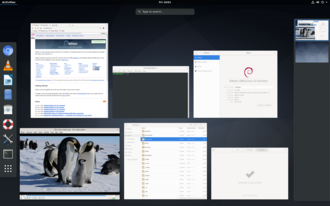
Debian releases do not follow a fixed schedule. Recent releases have been made around every two years by the Debian Project. The most recent version of Debian is Debian version 12, codename "Bookworm".[1] The next up and coming release of Debian is Debian 13, codename "Trixie".[2]
Debian always has at least three active branches at any time: "stable", "testing" and "unstable".[3] The stable branch is considered the primary release and what most people refer to when talking about Debian. The testing branch contains packages that have been imported from unstable. Testing has significantly more up-to-date packages than stable and is frozen some time before a release to become the next version of Debian. The unstable release (also known as Sid) is the branch where active development takes place. It is the most volatile version of Debian.
When the Debian stable branch is replaced with a newer release, the current stable becomes an "oldstable" release. When the Debian stable branch is replaced again, the oldstable release becomes the "oldoldstable" release. Oldoldstable is eventually moved to the archived releases repository.[4]
- ^ "Debian 11 "bullseye" released". 14 August 2021. Retrieved 15 August 2021.
- ^ "Debian 12 -- Release Notes". 14 August 2021. Retrieved 14 August 2021.
- ^ "Debian Releases". 30 December 2020. Retrieved 6 May 2021.
- ^ "1.6. Lifecycle of a Release". www.debian.org. Retrieved 14 May 2022.